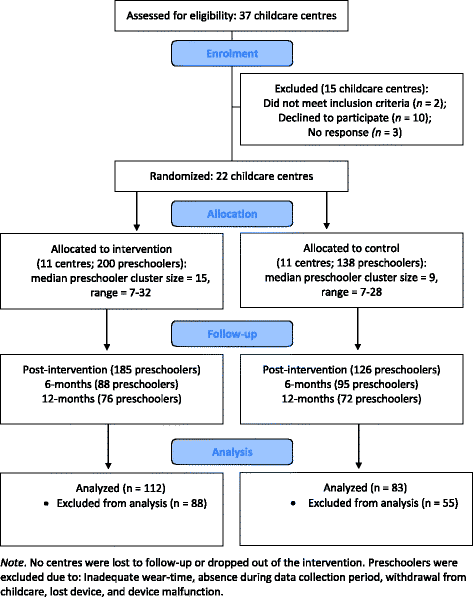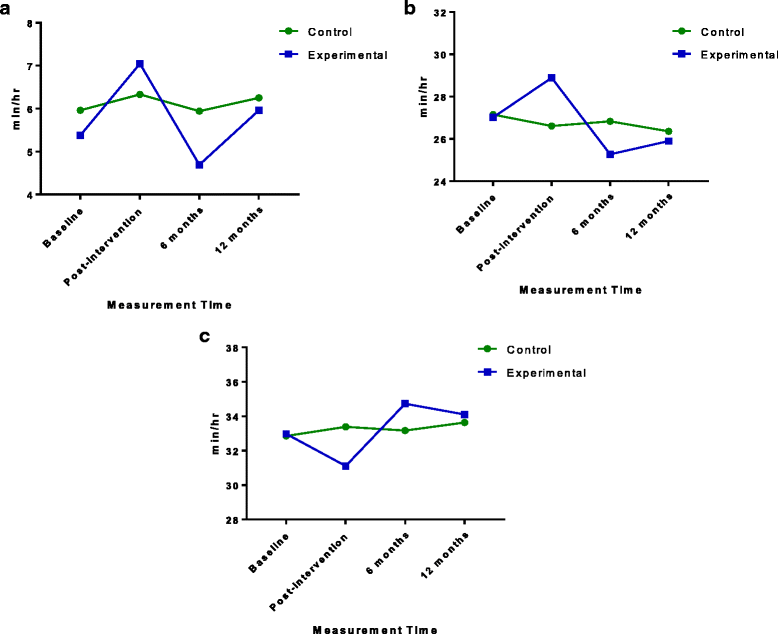Impact of the Supporting Physical Activity in the Childcare Environment (SPACE) intervention on preschoolers' physical activity levels and sedentary time: a single-blind cluster randomized controlled trial
- PMID: 28882152
- PMCID: PMC5590124
- DOI: 10.1186/s12966-017-0579-7
Impact of the Supporting Physical Activity in the Childcare Environment (SPACE) intervention on preschoolers' physical activity levels and sedentary time: a single-blind cluster randomized controlled trial
Abstract
Background: Physical activity levels among preschoolers in childcare are low and sedentary time high. The Supporting Physical Activity in the Childcare Environment (SPACE) intervention had three components: 1. portable play equipment; 2. staff training; and, 3. modified outdoor playtime (i.e., shorter, more frequent periods). This study aimed to examine the effectiveness of the SPACE intervention on preschoolers' physical activity levels and sedentary time during childcare hours (compared to standard care).
Methods: Via a single-blind cluster randomized controlled trial, 338 preschoolers (39.86 ± 7.33 months; 52% boys) from 22 centre-based childcare facilities (11 experimental, 11 control) were enrolled. Preschoolers wore an Actical™ accelerometer for 5 days during childcare hours at baseline, post-intervention, and 6- and 12-month follow-up, and were included in the analyses if they had a minimum of two valid days (5 h each day) at baseline and one additional time point. Intervention effectiveness was tested using a linear mixed effects model for each of the four outcome variables (i.e., sedentary time, light physical activity [LPA], moderate-to-vigorous physical activity [MVPA], and total physical activity [TPA]). Fixed effects were further evaluated with t-tests, for which degrees of freedom were estimated using a Satterthwaite approximation.
Results: One hundred and ninety-five preschoolers were retained for analyses. The intervention did not significantly impact LPA. MVPA was significantly greater among children in the experimental group when comparing post-intervention to pre-intervention, t(318) = 3.50, p = .0005, but no intervention effects were evident at 6- or 12-month follow-up. TPA was significantly greater for children in the intervention group at post-intervention when compared to pre-intervention, t(321) = 2.70, p = .007, with no intervention effects evident at later time periods. Finally, sedentary time was significantly lower among preschoolers in the experimental group when comparing post-intervention to pre-intervention, t(322) = 2.63, p = .009, with no significant effects at follow-up.
Conclusions: The SPACE intervention was effective at increasing MVPA and TPA among preschoolers, while simultaneously decreasing sedentary time. The ability of the SPACE intervention to target higher intensity activity is promising, as MVPA levels have been documented to be low in centre-based childcare. The changes in physical activity were not sustained long term (6- or 12-month follow-up).
Trial registration: ISRCTN70604107 (October 8, 2014).
Keywords: Childcare; Early years; Intervention; Outdoor playtime; Physical activity; Preschooler; Sedentary time.
Conflict of interest statement
Ethics approval and consent to participate
This study and all related documents received ethical approval from the University of Western Ontario’s Research Ethics Board (REB# 105779).
Consent for publication
Not applicable.
Competing interests
The authors declare that they have no competing interests.
Publisher’s Note
Springer Nature remains neutral with regard to jurisdictional claims in published maps and institutional affiliations.
Figures



References
-
- Vanderloo LM, Tucker P, Johnson AM, Burke SM, Irwin JD. Environmental influences on preschoolers' physical activity levels in various early learning facilities. Res Q Exerc Sport. 2015;19:1–11. - PubMed
-
- O'Dwyer MV, Fairclough SJ, Ridgers ND, Knowles ZR, Foweather L, Stratton G. Effect of a school-based active play intervention on sedentary time and physical activity in preschool children. Health Educ Res. 2013:1–12. - PubMed
Publication types
MeSH terms
Associated data
Grants and funding
LinkOut - more resources
Full Text Sources
Other Literature Sources
Medical
Miscellaneous

